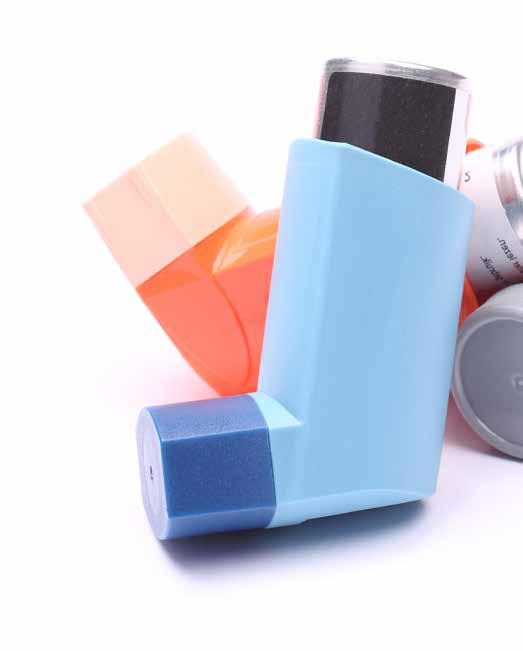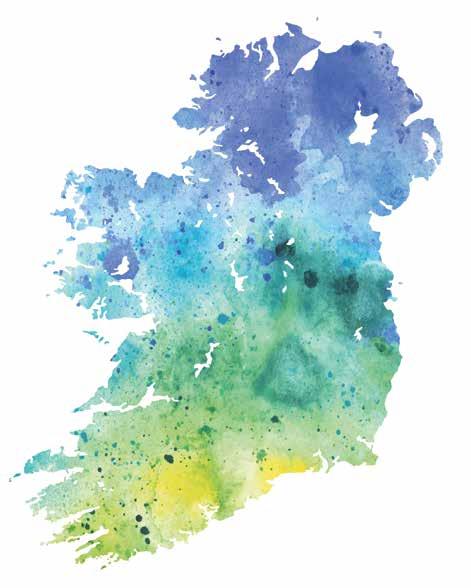
7 minute read
CROHN’S DISEASE AND ULCERATIVE COILITIS
Siún Tobin, MPSI
Senior Pharmacist, Our Lady's Hospice and Care Services. Specialising in cancer care, palliative care, and medicines information
TREATING AND MANAGING CROHN’S DISEASE AND UC
A clinical overview of Crohn’s disease and ulcerative colitis presentation and management strategies
Crohn’s disease (CD) and ulcerative colitis (UC) are collectively known as inflammatory bowel disease (IBD). An estimated 40,000 people in Ireland live with IBD, most of whom are diagnosed between the ages of 15 and 35 years. The main symptoms of IBD include: Diarrhoea; cramping pains in the abdomen; tiredness and fatigue; feeling generally unwell; loss of appetite and loss of weight; anaemia; and mouth ulcers. These disorders have both distinct and overlapping pathologic and clinical characteristics. CD is an inflammatory condition of unknown aetiology that can affect any portion of the gastrointestinal tract from the mouth to the perianal area. UC affects the colon exclusively and is characterised by inflammation of the mucosal layer, whereas CD is recognised by its transmural inflammatory nature. Although the pathogenesis of IBD remains undetermined, a number of risk factors have been identified, including male sex, genetic factors, and smoking.
Crohn’s disease
In people with CD, the immune system recognises the lining of the digestive tract as foreign and attacks it, causing inflammation. This inflammation causes the lining of the digestive tract to develop ulcers and bleed. The severity of CD varies greatly and depends on the site of inflammation and the extent of inflammation.
The vast majority of patients with CD (approximately 80 per cent) have small bowel involvement, with the remaining 20 per cent having disease limited to the colon. The mouth/oesophagus are less commonly considered as affected areas in CD but reportedly 5-to-15 per cent of patients have predominant involvement of the mouth or gastroduodenal area, while fewer patients have involvement of the oesophagus.
Clinical manifestations
It is common for patients to have persistent symptoms for many years prior to receiving a diagnosis of CD. The hall
mark symptoms of CD include fatigue, prolonged diarrhoea with abdominal pain, weight loss and fever, with or without gross bleeding.
Bleeding: Although stools often reveal the presence of microscopic levels of blood, gross bleeding is less frequent than in UC. The greater the colonic involvement, the more likely it is that melena will occur.
Malabsorption: Bile acids are normally absorbed by specific receptors in the distal ileum. Bile salt malabsorption occurs when this area is inflamed or diseased. Unabsorbed bile salts enter the colon, resulting in a secretory or ‘bile salt’ diarrhoea and fat malabsorption. Bile salt diarrhoea is watery and affects the reabsorption of electrolytes and water from the colon.
Other gastrointestinal involvement:
Severe oral involvement may present with aphthous ulcers or pain in the mouth and gums. Oesophageal involvement may present with odynophagia and dysphagia.
Ulcerative colitis
UC is characterised by recurring episodes of inflammation limited to the mucosal layer of the colon. Unlike CD, it commonly affects the rectum and may extend in a proximal and continuous fashion to involve other parts of the colon.
The diagnosis of UC is based on the presence of chronic diarrhoea for more than four weeks, and evidence of active inflammation on endoscopy and chronic changes on biopsy. Often, diarrhoea will contain blood. The onset of symptoms is usually gradual and symptoms are progressive over several weeks. Establishing the severity of a patient’s UC is critical in the management of their condition. It also has implications in terms of predicting the long-term impact of the colitis.
Clinical manifestations
UC, being an inflammatory bowel disease, will periodically present with acute symptoms. In between times, the disease can be quite stable and does not have to impact on patient activities of daily living.

Symptoms of acute exacerbations of UC include rectal bleeding, episodes of more than 10 stools per day, abdominal pain and distension and toxic symptoms, including fever and anorexia.
Drug treatment in IBD
Numerous therapies are used for the treatment of IBD. The choice of therapy will vary, depending upon the anatomic location of disease, the severity of disease, and the goal of therapy (ie, induction or maintenance of remission).
Oral 5-aminosalicylates (5-ASA) — sulfasalazine, olsalazine, mesalazine Although the precise mechanism responsible for the clinical efficacy of 5-aminosalicylic acid (5-ASA) compounds is not known, they are thought to act topically. In vitro investigations have identified many anti-inflammatory and immunosuppressive properties of 5-ASA, suggesting a multifactorial basis of therapeutic action. Since orally-ingested unconjugated 5-ASA undergoes rapid absorption in the jejunum, various formulations have been developed to prevent proximal absorption of
5-ASA and increase bioavailability in the distal small bowel and colon. Oral 5-ASAs such as mesalazine generally act in two-to-four weeks after the initiation of therapy.
Common side-effects of sulfasalazine and 5-ASAs include nausea and headache. Sulfasalazine has been associated with male infertility and, rarely, agranulocytosis. Transient, mild, watery diarrhoea can occur in patients on all oral 5-ASA preparations. Side-effects are less common where 5-ASA is administered rectally, rather than orally.
Second-line treatment for CD Antibiotics — ciprofloxacin, metronidazole
Antibiotics are generally indicated in patients with CD who do not tolerate 5-ASAs or do not improve within threeto-four weeks of starting a 5-ASA. It is unclear if the efficacy of antimicrobial therapy is due to treatment of an undetected pathogen in the gut lumen, alteration of the composition of the intestinal microbiota to favour beneficial bacteria, or treatment of micro abscesses.
Metronidazole and/or ciprofloxacin are generally used, though there is also limited evidence for the use of rifampicin and clarithromycin.
Second-line treatment for UC Topical steroids and treatment combinations
Patients who cannot tolerate topical 5-ASA medications should be treated twice daily with rectal steroid preparations for the induction of remission. Steroid foam preparations such as Budenofalk (budesonide) 2mg/dose rectal foam or prednisolone 20mg/dose rectal foam are both reimbursed by the HSE PCRS and may be useful. A response is usually seen in three-to-four weeks. In patients with a clear improvement in symptoms, topical steroid treatment can be tapered gradually to a nightly regimen. In the treatment of severe UC ((≥6 stools/day, severe cramps, anaemia, tachycardia) oral glucocorticoids are indicated in combination with high-dose oral 5-ASA.
Further treatments for CD Glucocorticoids — prednisolone, budesonide
Oral glucocorticoids are the mainstay of treatment for patients with mildto-moderate CD who are unresponsive to the above measures, or for those presenting with more severe initial symptoms. Initially, 40-to-60mg/day of prednisolone is generally prescribed and should be gradually tapered after 10-to-14 days. 5-ASA drugs and antibiotics can be used concomitantly with prednisolone.
Immunomodulators — azathioprine, 6-mercaptopurine, methotrexate
Immunomodulators are indicated only in severe or refractory IBD.
Azathioprine or its active metabolite, 6-mercaptopurine (6-MP), are occasionally indicated. Treatment can be initiated with either drug at a dose of 50mg/day and titrated upwards as required, depending on the response. The maximum licensed dose of azathioprine (Imuran) is 4mg/ kg/day. A response to these medications will usually be seen within three-to-six months of treatment. During this period, patients often require concomitant steroid therapy, with a gradual reduction in the steroid dose after one-to-two months of treatment with the immunomodulatory.
Methotrexate is an alternative for patients who do not tolerate or do not respond to azathioprine or 6-MP and may be preferable to azathioprine or 6-MP in patients with troublesome extra-colonic symptoms. To guarantee bioavailability, the drug should be initiated subcutaneously/intramuscularly using Metoject/ Nordimet products. A response should be seen within three months. Once a response to intramuscular methotrexate is achieved, the patient can be switched to oral therapy, if more tolerable.
Biologic therapies — adalimumab, infliximab, tofacitinib
Biologic therapies are best reserved for patients refractory to primary therapy or who are steroid-dependent. In Ireland, infliximab is an anti-tumour necrosis factor (anti-TNF) therapy licensed for the management of CD and UC. Additionally, adalimumab is licensed for the treatment of CD in persons from the age of six years in Ireland. Biosimilars for adalimumab are also now available on the HSE’s High- Tech Drug Scheme.
Tofacitinib (Xeljanz), a JAK inhibitor, is indicated for the treatment of adult patients with moderately- to severely-active UC who have had an inadequate response, lost response, or were intolerant to either conventional therapy or a biologic agent. The European Medicines Agency (EMA) initiated a review of this product in May 2019 following evaluation of data that suggest an increased risk of pulmonary embolism (PE) and overall mortality in patients using both the 5mg and 10mg twice daily doses of tofacitinib as compared with patients taking TNF-inhibitors. On 31 October 2019 the EMA’s safety committee (PRAC) published its findings which concluded that tofacitinib could increase the risk of blood clots in the lungs and in deep veins in patients who are already at high risk.
As a result, the PRAC recommended that tofacitinib should be used with caution in patients at high risk of blood clots. In addition, the maintenance doses of 10mg twice daily should not be used in patients with UC who are at high risk unless there is no suitable alternative treatment.
Further, the PRAC recommended that patients older than 65 years of age should be treated with tofacitinib only when there is no alternative treatment.
References on request









